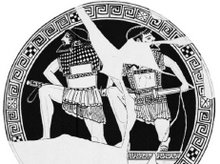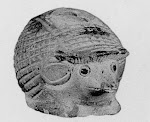 Let's review a bit. The aspis was a dome shaped shield. Domes are supremely suited to transferring force applied to their face around to their base. On a micro-scale this explains why pieces of armor like the Napoleonic cuirasse at right are curved. Because some portion of force applied to a curved face is transferred to the area around it, a curved plate makes stronger armor than a flat plate.
Let's review a bit. The aspis was a dome shaped shield. Domes are supremely suited to transferring force applied to their face around to their base. On a micro-scale this explains why pieces of armor like the Napoleonic cuirasse at right are curved. Because some portion of force applied to a curved face is transferred to the area around it, a curved plate makes stronger armor than a flat plate. 
A blow to a curved plate will compress the metal around the site of the impact as in figure A. An impact on a flat or bowl shaped plate, as in B, will stretch the adjoining metal rather than compressing it. Thus only the tensile strength of the metal resists the impact. Compressive strength is always higher in metals than tensile strength.
So on a small scale we can see that curvature helps resist impact. This is probably not a driving force behind the evolution of the aspis because the front of the dome, precisely where we would want this property maximized is flattened.
Once again we must seek a reason for the flattened dome shape.




4 comments:
I don't think I agree that the dome of a hoplite shield has to have a special explanation, Paul. Small, slightly domed round shields are pretty common (eg. the rotella or round target in sixteenth-century Europe, or the round shield of medieval Persia). Of course, Anglo-Saxon shields were often domed, and those were larger and used in shield walls where crowd pressure could have built up ...
I've only seen pictures of aspides, but most of them look like they curve smoothly until just before the rim.
Doesn't a rounded shape help blows glance off the shield?
Thanks for posting again! Your theories are very interesting, even if I'm not convinced.
Hey Sean, In previous posts I have examined all of the advantages of dome-shaped shields. The aspis was not uniformly dome-shaped- very few vase images depict it thus and no sculpural evidence that I am aware of from the classical period. They were very flattened domes. This forms the heart of my notion that the Aspis was something different from other curved shields.
I'm very interested in any information you can provide on later domed shields used in conjunction with shield-walls. One other shield we are told of that was useful in the press was the egyptian, which Xenophon says can be pushed with the shoulder. This has lead to, in my view, a great misunderstanding. He does not mean pushed sideways with the shoulder, he means pushed with the front of the shoulder as a football player pushes.
Hi Paul,
Blogger keeps eating my comments! I was thinking of Richard Underwood, "The Early Anglo-Saxon Shield: Reconstruction as an Aid to Interpretation," in Barry Molloy ed., The Cutting Edge (Tempus, 2007). There is a debate about whether any early medieval round shields were domed (they often look domed in art, but the best preserved finds of Norse shields are all flat). Underwood argues that domed shields would have been just as easy to make as flat ones with available technology.
Great reading your bllog post
Post a Comment